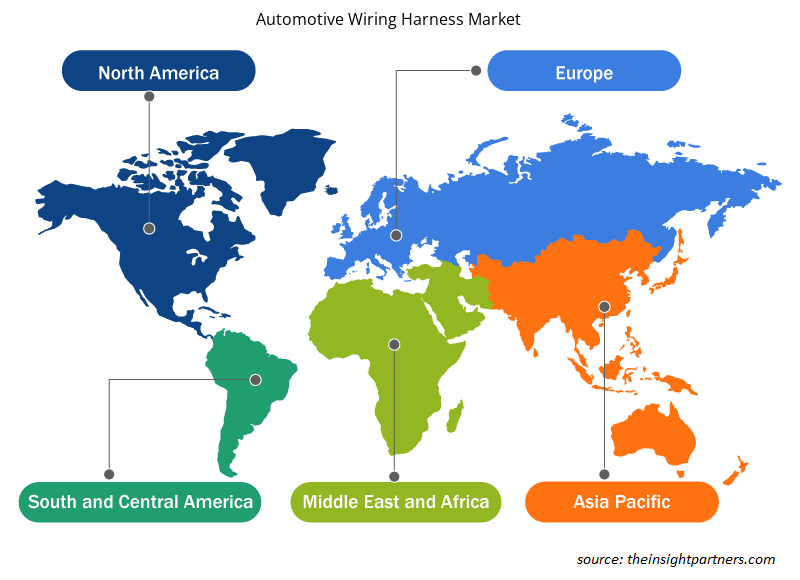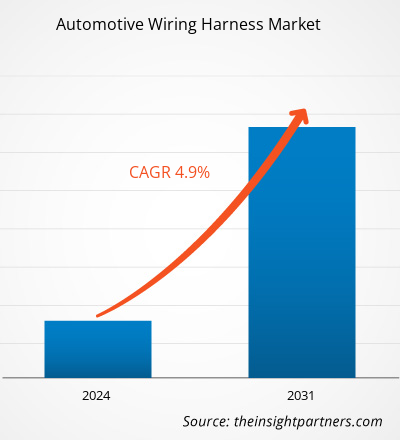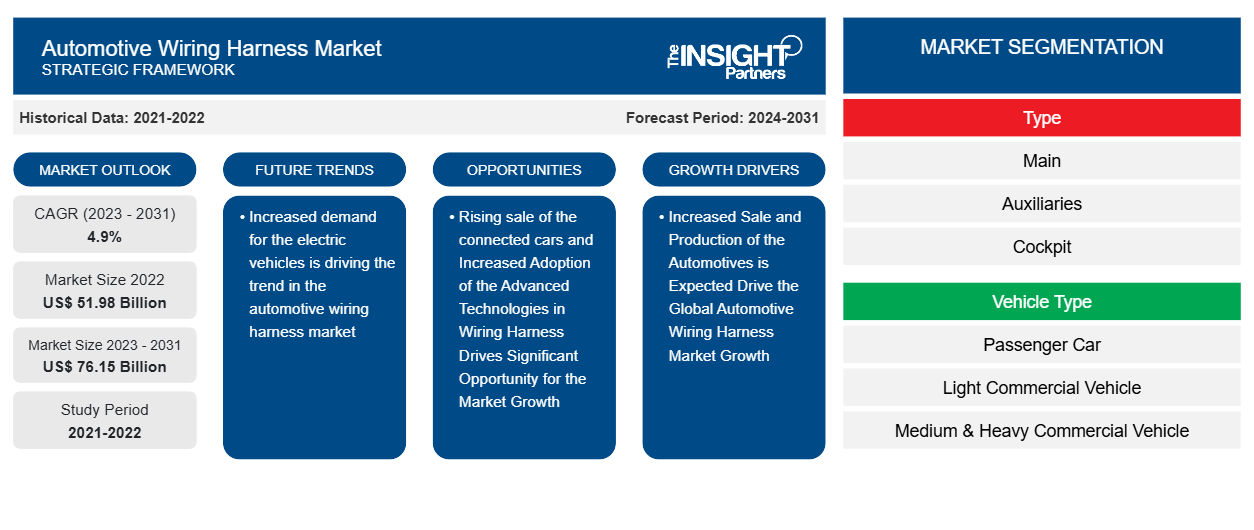Der Markt für Kabelbäume für Kraftfahrzeuge soll von 51,98 Milliarden US-Dollar im Jahr 2022 auf 76,15 Milliarden US-Dollar im Jahr 2031 anwachsen. Der Markt soll in den Jahren 2023–2031 eine durchschnittliche jährliche Wachstumsrate (CAGR) von 4,9 % verzeichnen. Der Markt für Kabelbäume für Kraftfahrzeuge wird durch steigende Automobilverkäufe und -produktion sowie ein steigendes verfügbares Einkommen der Bevölkerung angetrieben. Laut der Internationalen Organisation der Kraftfahrzeughersteller stiegen die Automobilverkäufe im Jahr 2023 auf 92,72 Millionen, was einem Anstieg von 11,8 % gegenüber 2022 entspricht. Dieses Wachstum der Automobilverkäufe hat weltweit eine enorme Nachfrage nach Kabelbäumen für Kraftfahrzeuge geschaffen.
Marktanalyse für Kabelbäume für Kraftfahrzeuge
Ein Kabelbaum ist ein elektrisches Verkabelungssystem im Fahrzeug. Die wichtigsten Anwendungen des Kabelbaums umfassen Fahrgestellstruktur, Bremsen und Kraftstoffleitungen. Im Auto wird ein umfangreiches Kabelnetz mit einer Vielzahl von elektrischen Systemen gebildet. Der Fahrzeugkabelbaum ist das elektrische Verteilungssystem im Fahrzeug. Ein Kabelbaum ist eine Reihe von Klemmen, Kabeln und Anschlüssen, die durch das gesamte Fahrzeug verlaufen. Strom und Informationen werden mithilfe einer Reihe von Kabelnetzen übertragen.
Marktübersicht für Kabelbäume für Kraftfahrzeuge
Autokabelbäume werden häufig in Dreirädern, Nutzfahrzeugen, Personenkraftwagen und Nutzfahrzeugen verwendet. Kabelbäume werden gemäß den elektrischen und geometrischen Fahrzeuganforderungen entwickelt, die in die Karosserie, den Verbrennungsmotor und das Fahrgestell von Fahrzeugen eingebettet sind. Autokarosseriekabelbäume werden in mehrere Fahrzeugkomponenten eingebaut, darunter Armaturenbretter, elektrische Fensterheber, Türschlösser und andere elektrische Innenraumkomponenten. Motorkabelbäume sind mit Feststellbremssystemen, Tempomatsystemen, Geschwindigkeitssensoren und Kraftstoffeinspritzsystemen ausgestattet. Die Fahrgestellverkabelung umfasst die hinteren, vorderen und Hauptkabelbäume.
Passen Sie diesen Bericht Ihren Anforderungen an
Sie erhalten kostenlose Anpassungen an jedem Bericht, einschließlich Teilen dieses Berichts oder einer Analyse auf Länderebene, eines Excel-Datenpakets sowie tolle Angebote und Rabatte für Start-ups und Universitäten.
-
Holen Sie sich die wichtigsten Markttrends aus diesem Bericht.Dieses KOSTENLOSE Beispiel umfasst eine Datenanalyse von Markttrends bis hin zu Schätzungen und Prognosen.
Treiber und Chancen auf dem Automobilkabelbaummarkt
Steigende Automobilverkäufe und -produktion treiben das Marktwachstum an
Da der Autoabsatz weiter wächst, treibt dies das Wachstum des Marktes für Autokabelbäume voran. Laut der Internationalen Organisation der Kraftfahrzeughersteller stiegen die Pkw-Verkäufe im Jahr 2023 auf 65,27 Millionen Einheiten, ein Anstieg von rund 12 % gegenüber 2022. Darüber hinaus stiegen die Nutzfahrzeugverkäufe im Jahr 2023 auf 27,45 Millionen Einheiten, ein Anstieg von 13,3 % gegenüber 2022. Ein solches Wachstum bei Pkw und Nutzfahrzeugen auf der ganzen Welt hat im Prognosezeitraum eine enorme Nachfrage nach dem Wachstum des Marktes für Autokabelbäume geschaffen.
Steigende Verkaufszahlen vernetzter Fahrzeuge und die verstärkte Nutzung fortschrittlicher Technologien zur Herstellung von Kabelbäumen eröffnen erhebliche Chancen für Marktwachstum.
Die Integration fortschrittlicher Technologien wie IoT-KI durch die wichtigsten Akteure dürfte dem Markt für Kabelbäume für Kraftfahrzeuge reichlich Gelegenheit zum Wachstum bieten. Mehrere wichtige Akteure auf dem Markt entwickeln fortschrittliche Lösungen für die Einführung von Kabelbäumen für Kraftfahrzeuge, indem sie Partnerschaften mit den Technologieanbietern eingehen. So ging die Yazaki Corporation im November 2023 eine Partnerschaft mit der NEC Corporation ein, um KI-basierte Lösungen für die automatische Entwicklung von Kabelbäumen für Kraftfahrzeuge herzustellen. Dieses System kombinierte die Digital Robot Planning Solution der NEC Corporation mit ihrem fortschrittlichen Robotersystem und Simulator für die Montage von Kabelbäumen für Kraftfahrzeuge bei der Yazaki Corporation.IoT AI by the key players is expected to create ample opportunity for the automotive wiring harness market growth. Several key players in the market are developing advanced solutions to launch the automotive wiring harness by forming partnerships with the technology providers. For instance, in November 2023, Yazaki Corporation partnered with NEC Corporation to manufacture AI-based to automatically develop automotive wiring harnesses. This system combined NEC Corporation’s Digital Robot Planning Solution with its advanced robotic system and simulator for automotive wiring harness assembly at the Yazaki Corporation.
Segmentierungsanalyse des Marktberichts für Kabelbäume für Kraftfahrzeuge
Wichtige Segmente, die zur Ableitung der Marktanalyse für Kabelbäume für Kraftfahrzeuge beigetragen haben, sind Typ, Plattform, Anwendung und Endbenutzer.
- Nach Typ ist der Markt in Zusatzgeräte, HVAC-Kabelbäume, Cockpit, ICE-Kabelbaum, E-Motor-Kabelbaum und Sonstiges unterteilt. Darunter hat der Cockpit-Kabelbaum im Jahr 2023 den größten Anteil. Dies ist in erster Linie auf die gestiegene Nachfrage der Verbraucher nach digitalem Zubehör für ihre Pkw zurückzuführen.HVAC wiring harnesses, Cockpit, ICE Harness, E-Motor Harness, and Others. Mong these, cockpit harness has the largest share in 2023. This is primarily owing to increased demand for digital accessories by consumers in their passenger cars.
- Nach Fahrzeugtyp betrachtet besteht der Markt aus Pkw, leichten Nutzfahrzeugen sowie mittleren und schweren Nutzfahrzeugen. Darunter haben leichte Nutzfahrzeuge im Jahr 2023 den größten Anteil. Dies ist auf den weltweit gestiegenen Absatz von Nutzfahrzeugen zurückzuführen.
Marktanteilsanalyse für Kabelbäume für Kraftfahrzeuge nach geografischer Lage
Der geografische Umfang des Marktberichts für Kabelbäume für Kraftfahrzeuge ist hauptsächlich in fünf Regionen unterteilt: Nordamerika, Europa, Asien-Pazifik, Naher Osten und Afrika sowie Südamerika.
Der asiatisch-pazifische Raum wird voraussichtlich im Jahr 2023 den globalen Markt für Kabelbäume für Kraftfahrzeuge dominieren. China, Japan und Indien sind im Prognosezeitraum die am schnellsten wachsenden Länder auf dem Markt für Kabelbäume für Kraftfahrzeuge. Dies ist in erster Linie auf den Anstieg der Automobilverkäufe und -produktion bei gleichzeitig steigendem verfügbaren Einkommen der Bevölkerung des Landes zurückzuführen. Im März 2023 beliefen sich die Automobilverkäufe und -produktion auf insgesamt 2,68 Millionen Einheiten, ein Anstieg um 4 % von 2,694 Millionen Einheiten im Vergleich zum Februar 2023. Ein solches Wachstum der Automobilproduktion in ganz China hat während des Marktwachstums eine enorme Nachfrage nach dem Markt für Kabelbäume für Kraftfahrzeuge geschaffen.
Regionale Einblicke in den Markt für Kabelbäume für Kraftfahrzeuge
Die regionalen Trends und Faktoren, die den Markt für Kabelbäume für Kraftfahrzeuge im Prognosezeitraum beeinflussen, wurden von den Analysten von Insight Partners ausführlich erläutert. In diesem Abschnitt werden auch die Marktsegmente und die Geografie für Kabelbäume für Kraftfahrzeuge in Nordamerika, Europa, im asiatisch-pazifischen Raum, im Nahen Osten und Afrika sowie in Süd- und Mittelamerika erörtert.

- Erhalten Sie regionale Daten zum Markt für Kabelbäume für Kraftfahrzeuge
Umfang des Marktberichts zum Kabelbaum für Kraftfahrzeuge
| Berichtsattribut | Details |
|---|---|
| Marktgröße im Jahr 2022 | 51,98 Milliarden US-Dollar |
| Marktgröße bis 2031 | 76,15 Milliarden US-Dollar |
| Globale CAGR (2023 - 2031) | 4,9 % |
| Historische Daten | 2021-2022 |
| Prognosezeitraum | 2024–2031 |
| Abgedeckte Segmente |
Nach Typ
|
| Abgedeckte Regionen und Länder |
Nordamerika
|
| Marktführer und wichtige Unternehmensprofile |
|
Marktteilnehmerdichte für Kabelbäume für Kraftfahrzeuge: Auswirkungen auf die Geschäftsdynamik verstehen
Der Markt für Kabelbäume für Kraftfahrzeuge wächst rasant. Dies wird durch die steigende Nachfrage der Endnutzer aufgrund von Faktoren wie sich entwickelnden Verbraucherpräferenzen, technologischen Fortschritten und einem größeren Bewusstsein für die Vorteile des Produkts vorangetrieben. Mit der steigenden Nachfrage erweitern Unternehmen ihr Angebot, entwickeln Innovationen, um die Bedürfnisse der Verbraucher zu erfüllen, und nutzen neue Trends, was das Marktwachstum weiter ankurbelt.
Die Marktteilnehmerdichte bezieht sich auf die Verteilung der Firmen oder Unternehmen, die in einem bestimmten Markt oder einer bestimmten Branche tätig sind. Sie gibt an, wie viele Wettbewerber (Marktteilnehmer) in einem bestimmten Marktraum im Verhältnis zu seiner Größe oder seinem gesamten Marktwert präsent sind.
Die wichtigsten auf dem Markt für Kabelbäume für Kraftfahrzeuge tätigen Unternehmen sind:
- Yazaki-Unternehmen
- Sumitomo Electric Industries
- Aptiv PLC
- Elektro Furukawa
- Leoni AG
- Lear Corporation, Coroplast Fritz Müller GmbH & Co.
Haftungsausschluss : Die oben aufgeführten Unternehmen sind nicht in einer bestimmten Reihenfolge aufgeführt.

- Überblick über die wichtigsten Akteure auf dem Markt für Kabelbäume für Kraftfahrzeuge
Neuigkeiten und aktuelle Entwicklungen zum Markt für Kabelbäume für Kraftfahrzeuge
Der Markt für Kabelbäume für Kraftfahrzeuge wird durch die Erhebung qualitativer und quantitativer Daten nach Primär- und Sekundärforschung bewertet, die wichtige Unternehmensveröffentlichungen, Verbandsdaten und Datenbanken umfasst. Im Folgenden finden Sie eine Liste der Entwicklungen auf dem Markt für Kabelbäume für Kraftfahrzeuge und der Strategien:
- Im November 2023 und September 2022 erwarb Aptiv Plc Intercable Automotive Solutions von Intercable Srl für 600,95 Millionen US-Dollar. Nach dieser Übernahme besaß Aptiv Plc 85 % der Anteile an Intercable Automotive Solutions. Durch die Übernahme erlangte Aptiv Plc eine führende Position im Bereich der Fahrzeugkabelbäume . (Quelle: Flyability, Pressemitteilung/Unternehmenswebsite/Newsletter)
- September 2022: Motherson Sumi Ltd. begann in Serbien am Standort Požarevac mit der Herstellung von Kabelbäumen für Kraftfahrzeuge. Das Werk wurde zur Herstellung von Kabelbäumen für Kraftfahrzeuge für Daimler Trucks errichtet. (Quelle: Flyability, Pressemitteilung/Unternehmenswebsite/Newsletter)
Marktbericht zum Thema Kabelbäume für Kraftfahrzeuge – Umfang und Ergebnisse
Der Bericht „Marktgröße und Prognose für Kabelbäume für Kraftfahrzeuge (2021–2031)“ bietet eine detaillierte Analyse des Marktes, die die folgenden Bereiche abdeckt:
- Marktgröße und Prognose auf globaler, regionaler und Länderebene für alle wichtigen Marktsegmente, die im Rahmen des Projekts abgedeckt sind
- Marktdynamik wie Treiber, Beschränkungen und wichtige Chancen
- Wichtige Zukunftstrends
- Detaillierte PEST-Analyse
- Globale und regionale Marktanalyse mit wichtigen Markttrends, wichtigen Akteuren, Vorschriften und aktuellen Marktentwicklungen
- Branchenlandschaft und Wettbewerbsanalyse, einschließlich Marktkonzentration, Heatmap-Analyse, prominenten Akteuren und aktuellen Entwicklungen
- Detaillierte Firmenprofile mit SWOT-Analyse
- Historische Analyse (2 Jahre), Basisjahr, Prognose (7 Jahre) mit CAGR
- PEST- und SWOT-Analyse
- Marktgröße Wert/Volumen – Global, Regional, Land
- Branchen- und Wettbewerbslandschaft
- Excel-Datensatz
Aktuelle Berichte
Erfahrungsberichte
Grund zum Kauf
- Fundierte Entscheidungsfindung
- Marktdynamik verstehen
- Wettbewerbsanalyse
- Kundeneinblicke
- Marktprognosen
- Risikominimierung
- Strategische Planung
- Investitionsbegründung
- Identifizierung neuer Märkte
- Verbesserung von Marketingstrategien
- Steigerung der Betriebseffizienz
- Anpassung an regulatorische Trends























 Kostenlose Probe anfordern für - Markt für Autokabelbäume
Kostenlose Probe anfordern für - Markt für Autokabelbäume